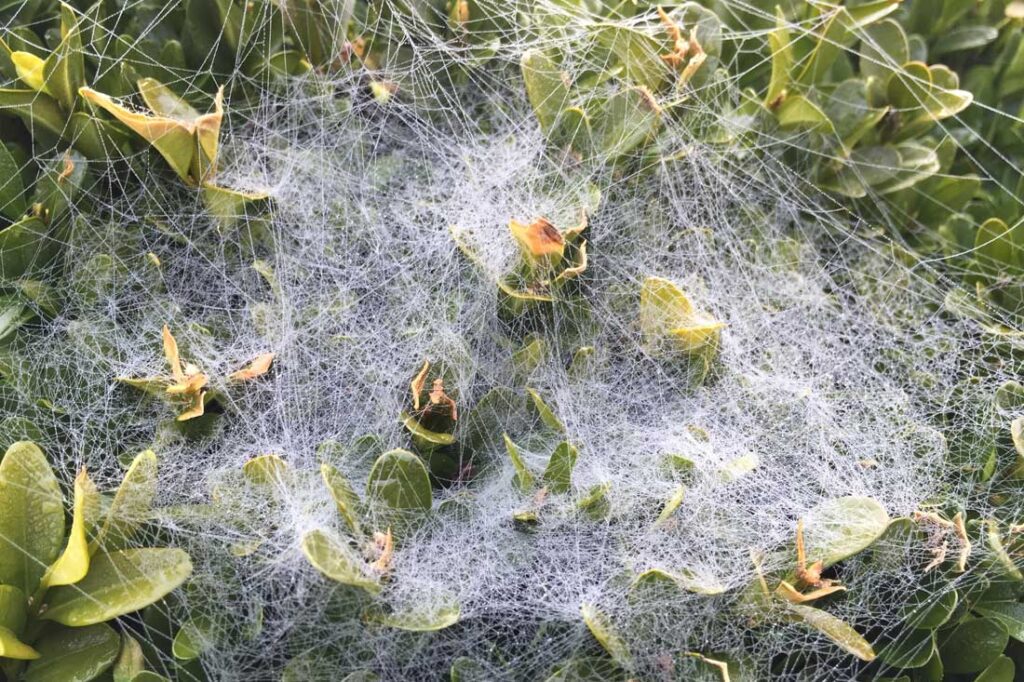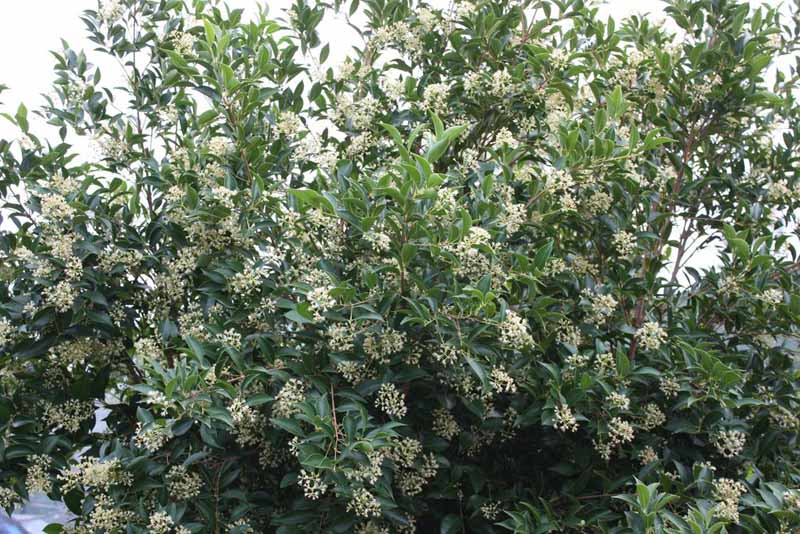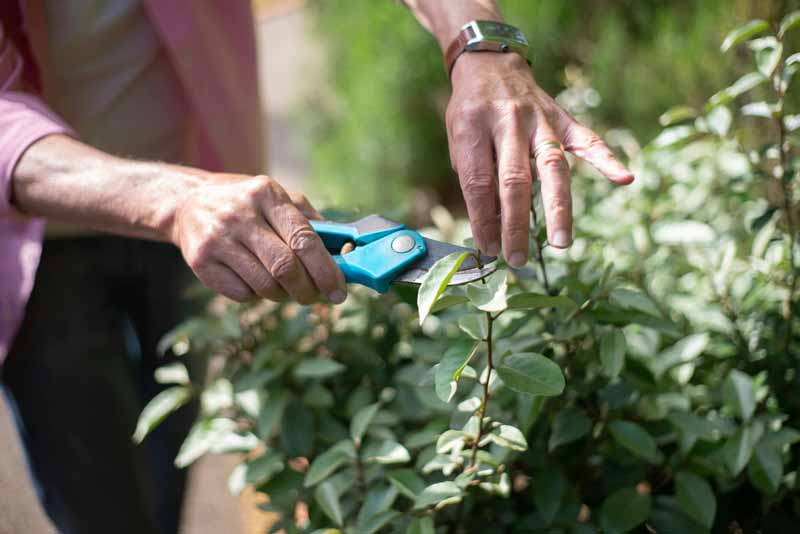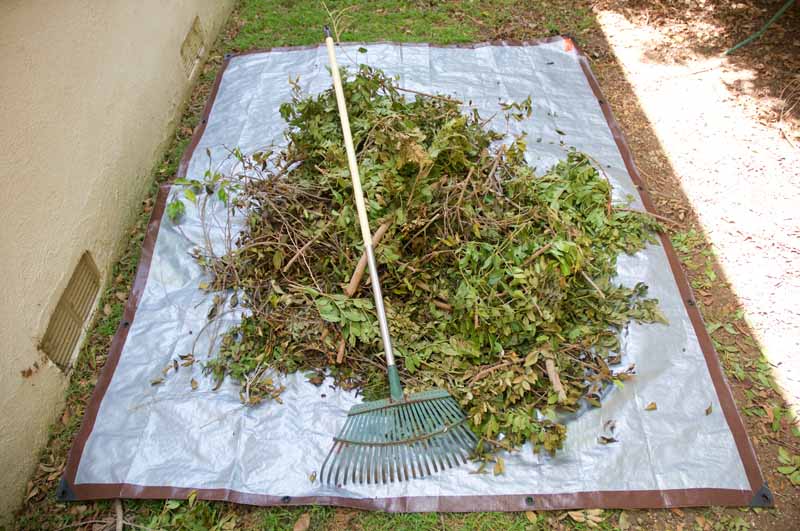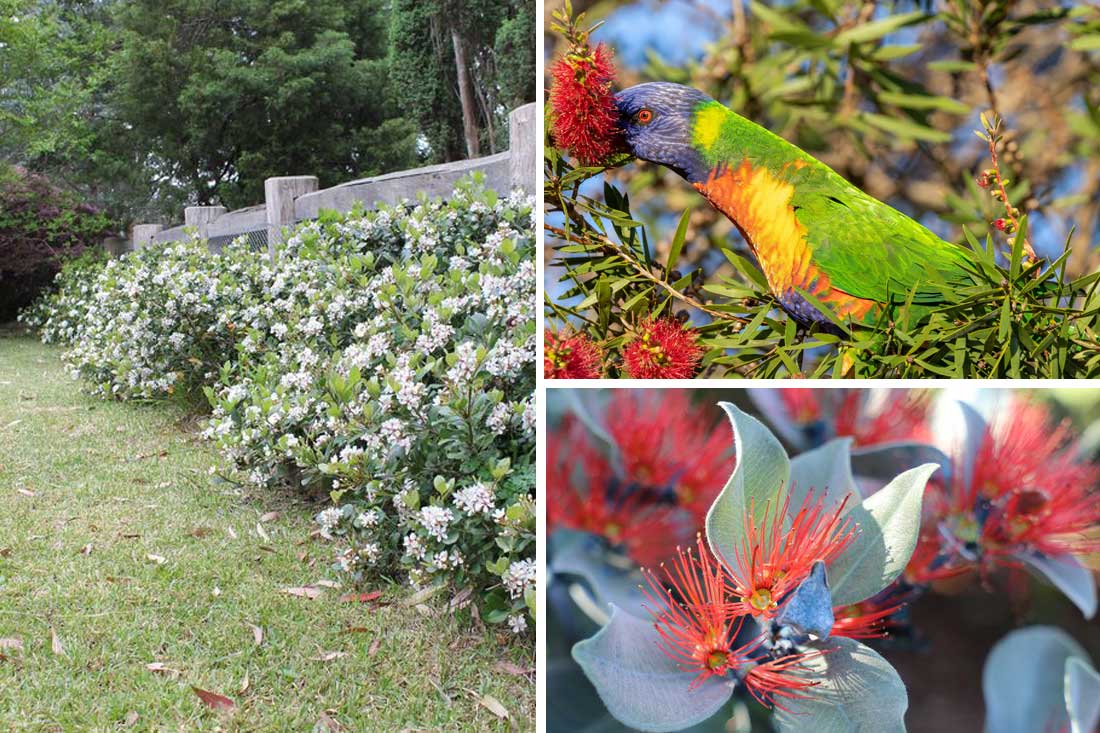Are your hedges looking a little under the weather? It’s not just you; hedges across Australia are susceptible to various pests and diseases. But don’t despair! This guide will help you identify and tackle some of the most common problems, ensuring your hedges remain healthy and beautiful all year round.
Of course, it isn’t possible to cover every single pest or disease that can infect our hedges, but this article covers some of the major ones you’re likely to encounter. It’s also important to acknowledge that the information in this article is highly over-simplified. Use this resource as a starting point in your Integrated Pest Management (IPM) journey.
Integrated Pest Management (IPM)
Before we go over the specific pests and diseases, it’s a good idea to understand the IPM approach that professionals use to control pests and diseases.
Integrated Pest Management (IPM) is a holistic, sustainable approach to managing pests by combining biological, cultural, physical, and chemical tools in a way that minimises economic, health, and environmental risks. One of the primary goals of IPM is to optimise pest control in an economically viable, environmentally sound and socially acceptable manner. It involves the following methods:
Proper plant selection is a key aspect, which we refer to as genetic controls. Some plant varieties are naturally more resistant or tolerant to certain pests and diseases. By choosing these varieties, you can reduce the need for additional pest control measures. This includes selections made at the family, genus, species and cultivar levels. For example, Myrtaceae family members are naturally high in essential oils that prevent most pests, but they’re still susceptible to lerps, aphids, and a few other select pests. Meanwhile, Sublime™ Acmena smithii ‘DOW30’ PBR is a specific cultivar in the Myrtaceae family that’s naturally resistant to psyllids.
Cultural controls involve modifying the environment, conditions, or the plants themselves to discourage pests. This could include practices such as crop rotation, intercropping, and sanitation to prevent or reduce pest populations.
Physical controls involve direct measures to kill or remove pests, or to make the environment unsuitable for them. This could include hand-picking pests, using barriers or traps, or physically attacking pests with a jet of water from a hose.
Biological controls involve using the pests’ natural enemies to control their population. This could include predators, parasitoids, or pathogens that can reduce the pest population. You can buy predators for a quick fix, but if you craft a biodiverse garden with shelter from wind, a source of water, and plenty of diverse plants and flowers, you’ll naturally attract predators and parasitoids.
As a last resort, chemical controls involve the use of pesticides to kill pests. In an IPM approach, pesticides are used only when necessary, and in combination with other control methods. The least harmful products are chosen, and they are applied in a way that minimises harm to non-target organisms and the environment. Usually, you’d start with some horticultural oil, then work your way up to a selective pesticide that only targets the type of pest you’re aiming for. Broad-spectrum, harmful chemicals are rarely used in an IPM approach.
Regulatory controls involve the use of policies and regulations to prevent the introduction or spread of pests. This could include quarantines, inspections, or bans on the importation of certain plants known to carry pests.
Now, let’s go over some common pests and diseases found in Australian hedges.
Aphids
Identification: Aphids are small, soft-bodied insects that feed on plant sap, which can cause leaves to curl and distort. They’re usually found on the undersides of leaves or on young shoots. They may also produce a sticky substance known as honeydew, which can lead to sooty mould growth.
Treatment: An IPM approach for aphids involves introducing beneficial insects like ladybirds, micro wasps, hoverflies and lacewings, which are natural enemies of aphids. Horticultural oils can also be used to knock a population back if the infestation is severe. Regular monitoring and early intervention can prevent significant damage.
Aphids come in a range of colours, but they generally look a little something like this. Rarely do they have wings.
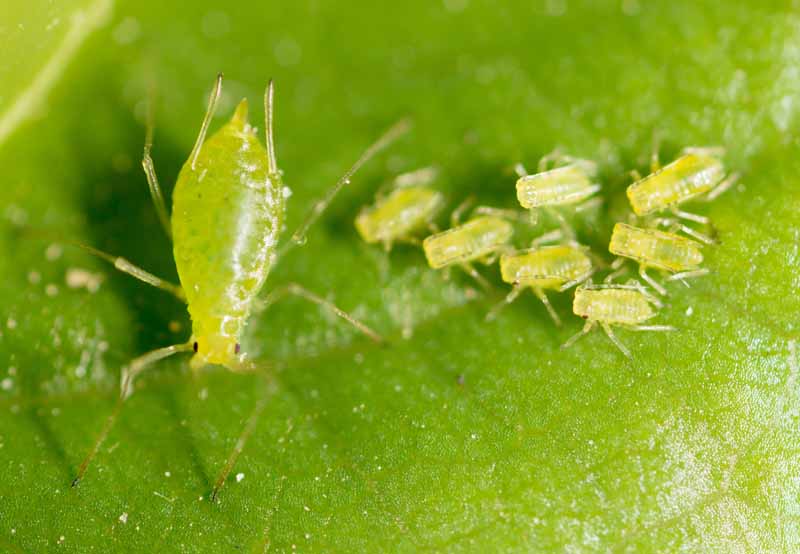
Scale Insects
Identification: Scale insects are small, immobile pests that attach themselves to the stems and leaves of plants. They’re covered by a waxy or shell-like cover, and can vary in colour from white to brown. Scale insects feed on plant sap, leading to yellowing leaves, stunted growth, and potentially plant death.
Treatment: Treat scale similarly to their relatives, aphids. Encouraging natural enemies such as parasitic wasps or using horticultural oils can be effective. Regular inspections are crucial for early detection and treatment.
These scale insects are on a Ficus elastica leaf.
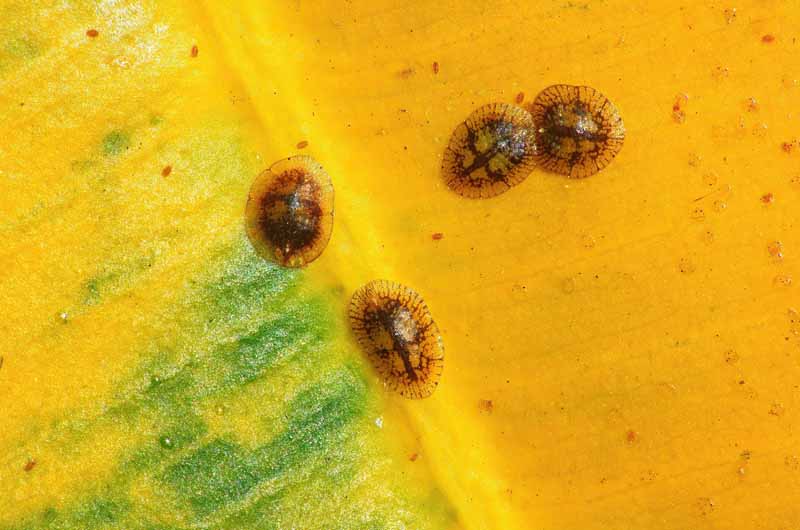
Psyllids
Identification: Psyllids are small insects that cause damage to leaves, causing distinctive ‘blisters’ or lumps. As true bugs, they’re related to scale and aphids and can affect a range of plants and can cause significant damage if left unchecked.
Treatment: Removing infested plant material early in an infestation and using horticultural oils can manage psyllids. Encouraging natural predators like ladybirds can also help keep their numbers in check. Make sure to monitor your plants regularly.
Psyllids can look different depending on the species and host plant. This is what lilly pilly psyllids look like.
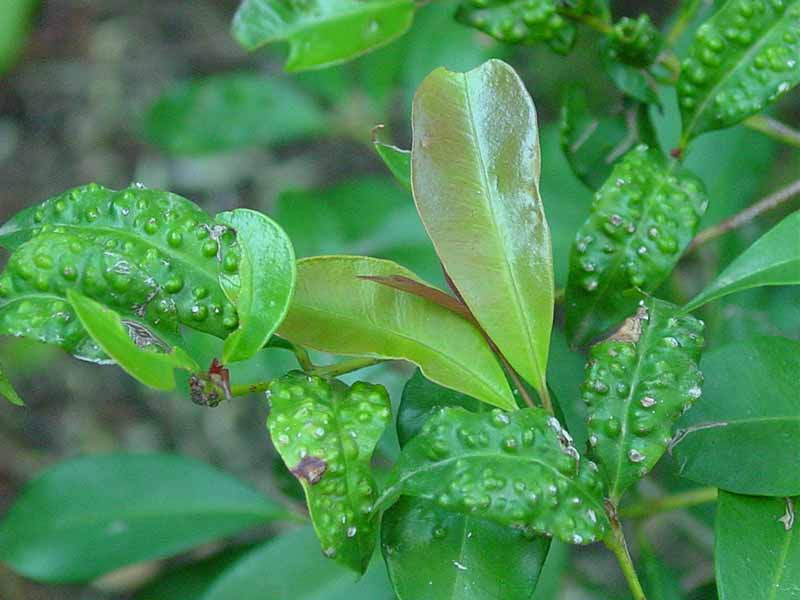
Spider Mites
Identification: Spider mites are tiny arachnids that feed on plant sap, causing stippling, yellowing of leaves, or the removal of leaf pigment altogether. They often create a fine webbing on the undersides of leaves. Remember that not all mites are pests – some are voracious predators that can help keep pest populations in check.
Treatment: Regularly hosing down your plants can help deter spider mites. Introducing natural predators like ladybugs, predatory mites, or lacewings can also help control them. In severe cases, horticultural oils or miticides may be necessary.
Extreme infestations of pest mites can create serious webbing like this.
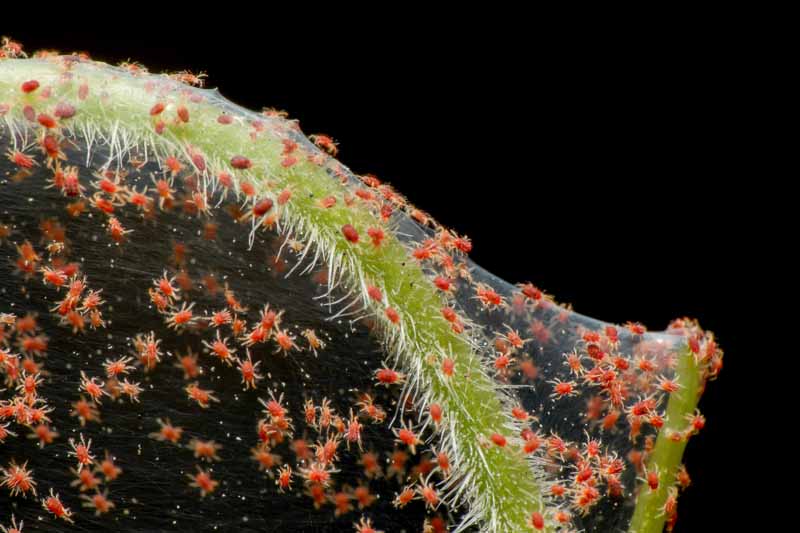
Black Sooty Mould
Identification: Sooty mould is a black fungus that grows on honeydew excreted by certain pests like aphids, scale, psyllids, mites, and others with sucking mouth parts. It can cover leaves and stems, reducing photosynthesis and plant vigour. Plus, it can look unsightly.
Treatment: Controlling the pests that produce the honeydew can help manage Sooty mould. In order to remove the mould from leaves, you need to physically scrub each leaf with soap. Most horticulturists would simply remove the pest, and wait for new growth to cover the older leaves with the sooty mould.
This is why they call it “black sooty mould.”
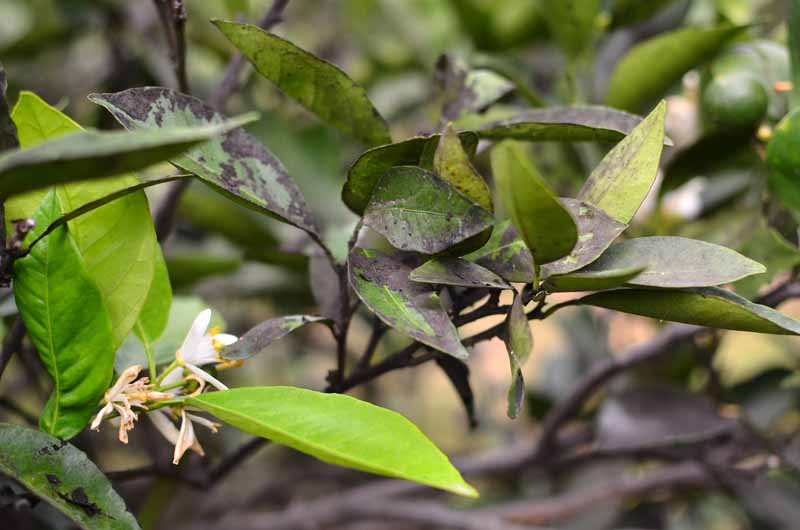
Leaf Miners
Identification: Leaf miners are larvae of certain insects (especially true flies) that tunnel through leaves, creating distinctive winding trails. This damage can cause the leaves to turn yellow or brown.
Treatment: Removing and disposing of affected leaves can help reduce leaf miner populations. Biological controls such as specific parasitic wasps can also be effective.
Leaf miners quite literally mine the inner parts of leaves, creating hollow tunnels that can be easily identified.
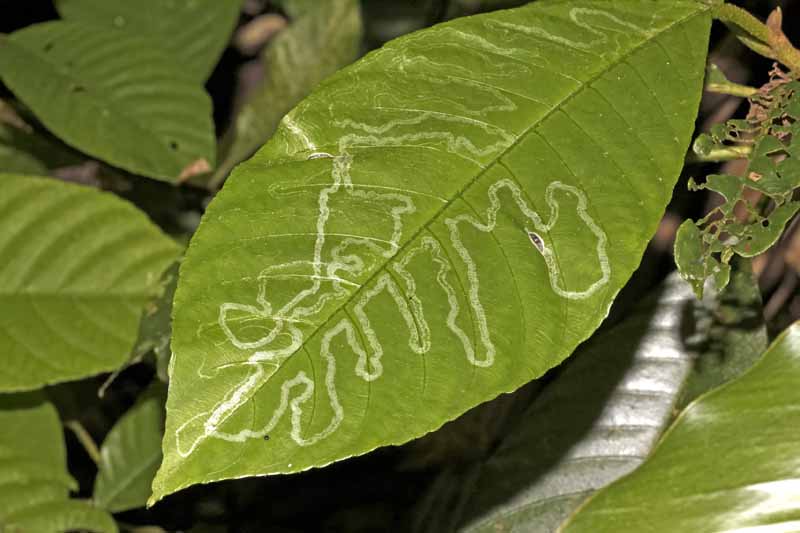
Gall Wasps
Identification: Gall wasps lay their eggs inside plant tissue (including stems and leaves), causing abnormal growths or ‘galls’. These can vary in appearance depending on the species of wasp.
Treatment: Pruning out and destroying galls can help control gall wasp populations. Other types of wasp can pierce galls and lay eggs that will hatch into larvae that feed on gall wasp larvae. There are also some chemical controls available.
If you’ve ever seen weird growths on your acacia hedge, the culprit may look a little bit like this.
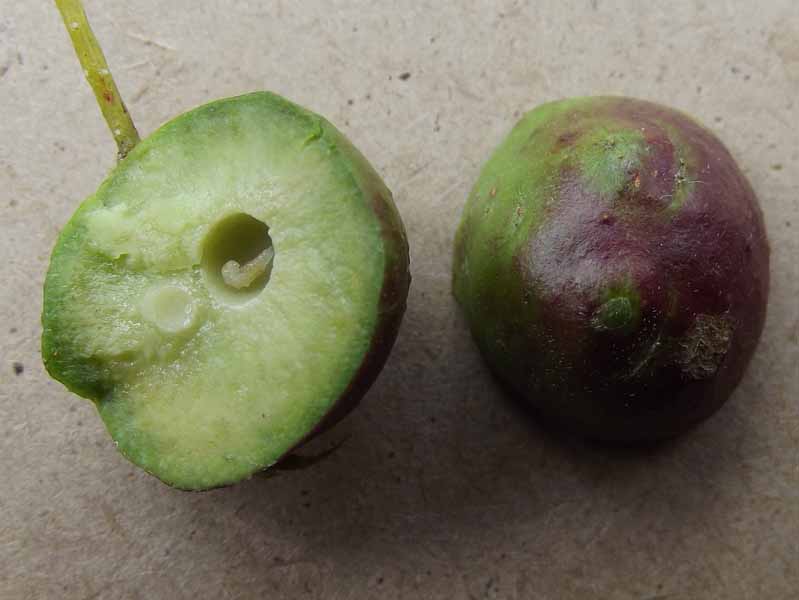
Grasshoppers
Identification: Grasshoppers can defoliate plants quickly, leaving behind only the stems. They are most destructive in large numbers.
Treatment: Natural predators like birds, frogs, and snakes can help control grasshopper populations. Insecticides can also be used but should be a last resort due to their potential impact on beneficial insects.
Grasshoppers have munching mouth parts they use to chomp holes in your hedges’ leaves.
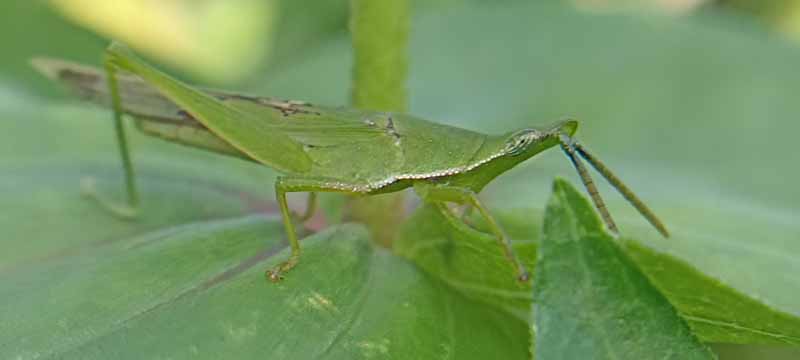
Beetles
Identification: Beetles can cause a variety of damages to plants, from eating leaves and flowers to boring into stems or roots. Remember that not all beetles are pests; in fact, many beetles are highly beneficial such as ladybirds, ground beetles and rove beetles.
Treatment: Handpicking beetles off your plants can be effective for small infestations. For larger infestations, consider using a botanical insecticide or introducing natural predators.
This little beetle is probably responsible for the holes in your lilly pilly hedges.
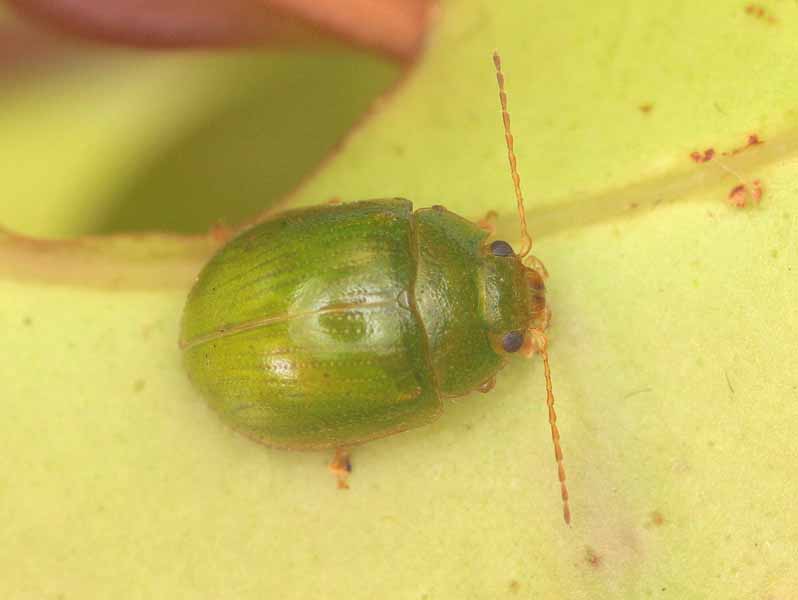
Weevils
Identification: Weevils are one type of true beetle that cause damage to plants both as adults and larvae. Not all weevils are pests, but the pest species can feed on leaves, roots, and even dense wood. Infested plants may show signs of leaf munching, wilting, yellowing, and unexpected plant death. They have a hard shell, an elongated mouth, and can come in a range of different patterns and textures.
Treatment: Biological control methods such as the use of nematodes can be effective against weevil larvae. Assassin bugs can pierce weevil armour and suck the juices out of them. Chemical control may also be necessary in severe cases. Regular monitoring of plants, especially during the evening when adult weevils are more active, can help detect an infestation early.
This weevil is munching on a leaf.
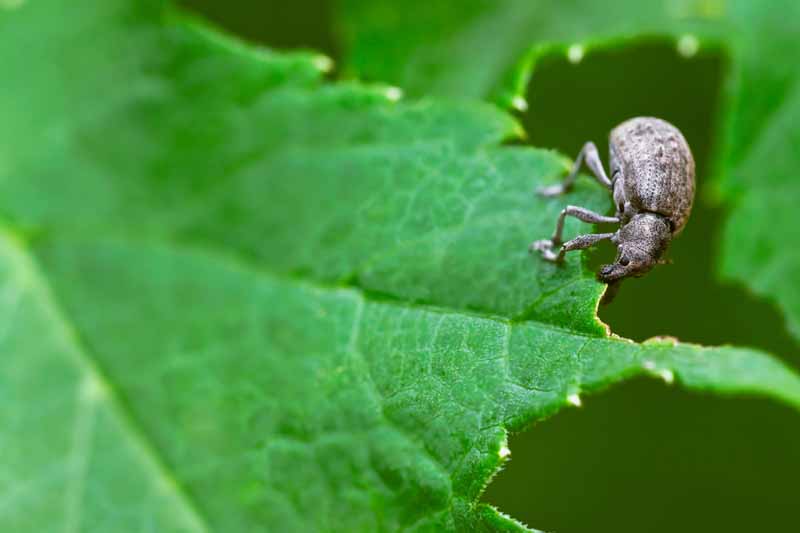
Caterpillars
Identification: Caterpillars are the larvae of moths and butterflies. Some are pests that feed on the leaves of a range of plants. Infested plants may display holes in leaves, webbing, reduced vigour, and in severe cases, total defoliation. Just because you see a caterpillar feeding on a plant, that doesn’t mean you should immediately kill it. A few caterpillars here and there are a sign of a healthy ecosystem, and they may grow into beautiful native butterflies that are a pleasure to have in the garden.
Treatment: Handpicking, spraying leaves with water, or applying biological controls like the bacteria Bacillus thuringiensis can manage these pests. Parasitoid wasps, ladybirds, birds, and other natural enemies love to feed on these insects. Regular monitoring can help detect an infestation early.
Some caterpillars can protect themselves from natural enemies using web.
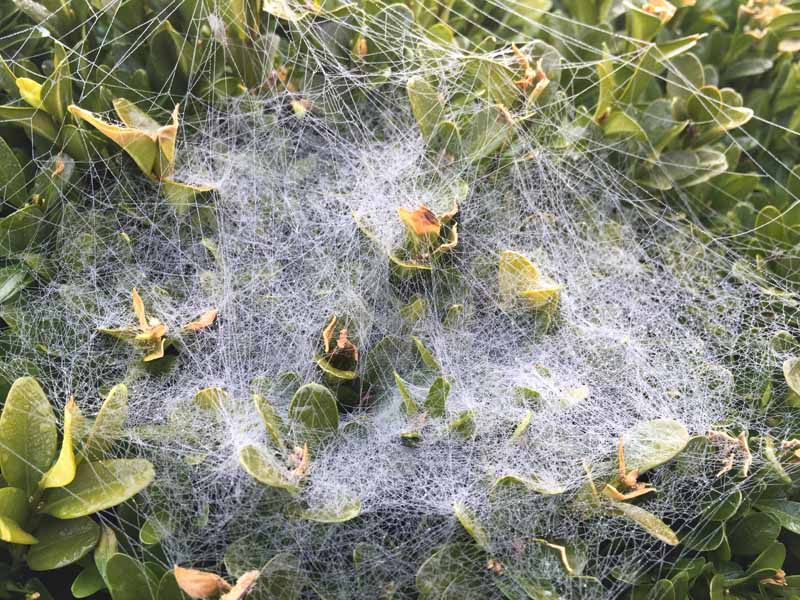
Snails and Slugs
Identification: Snails and slugs are common pests that eat a variety of plant material. They’re easily identifiable by their soft bodies, slimy trail and in the case of snails, their coiled shell. They’re most active at night, especially in the cooler months, and will hide during the day.
Treatment: Handpicking or introducing natural predators like ducks or chickens can control snails and slugs effectively. Providing a less hospitable environment by removing hiding places can also deter these pests. Or, you can lay down some cardboard each afternoon near infected plants, and check under that cardboard each morning to remove large numbers every day.
Snails are pretty easy to identify once you’ve spotted them.
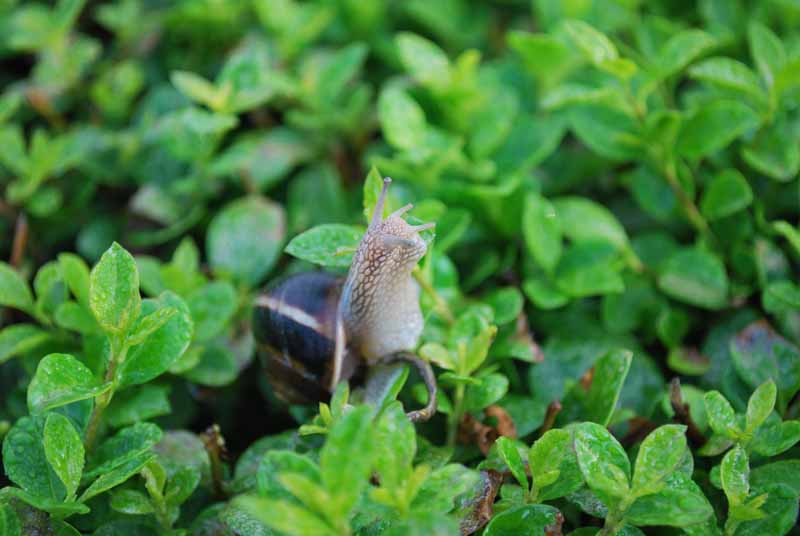
Mammal Pests (Rabbits, Deer, Rats, Possums)
Identification: Mammal pests can cause various damages to your hedges. Rabbits and deer tend to browse on the leaves and stems, while rats and possums may strip bark or eat fruits and flowers. Look for gnaw marks, stripped branches, or droppings as signs of these pests.
Treatment: Fencing is often the most effective way to keep larger mammals like rabbits and deer out of your garden. For smaller animals like rats and possums, consider using traps or deterrents. Always ensure any control methods used are humane and comply with local regulations.
This newly planted hedgerow is being protected by tubes against rabbits.
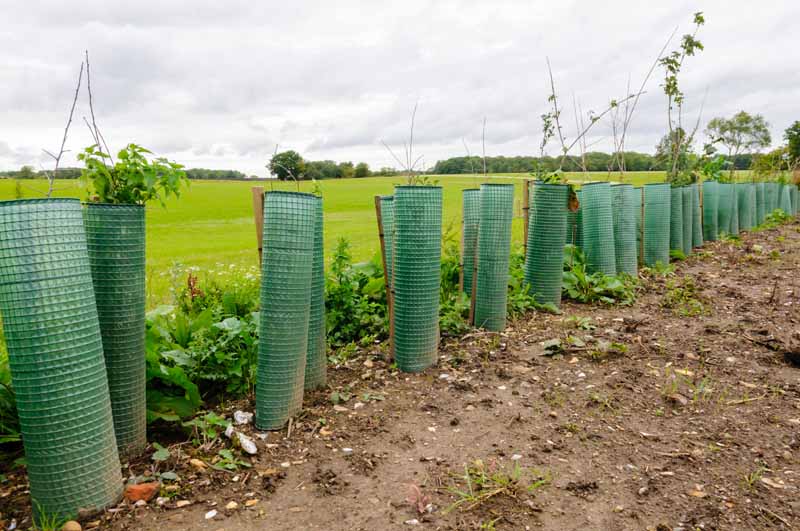
Myrtle Rust
Identification: Myrtle Rust is a severe fungal disease that impacts plants in the Myrtaceae family, which includes many Australian natives. The disease presents as bright yellow or orange spores on infected leaves, stems, or fruits. Infected plants may also display dieback, leaf drop, and reduced flowering.
Treatment: An IPM approach to Myrtle Rust involves several steps. Firstly, remove and destroy infected plant parts to prevent the fungus from spreading. Clean any utensils (and your hands) before moving to uninfected parts. Fungicides can also be used, but their effectiveness can vary depending upon the stage of infection. These chemical applications can also cause disruption to the soil biota, which can in turn cause health problems for nearby plants.
Myrtle rust can show as purple, orange, red or yellow spots on leaves, often with patches of dead (necrotic) tissue. It can also show yellow or orange “rust” fruiting spores along leaves, fruits, flowers and stems.
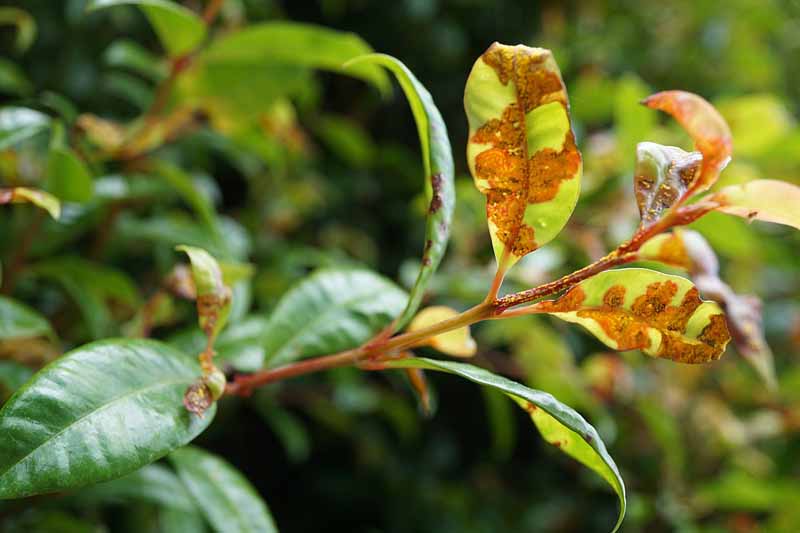
Cypress Canker
Identification: Cypress canker is a fungal disease characterised by browning foliage and branches, often starting at the top of the tree and moving downwards. Infected trees may also display resin oozing from the trunk or branches.
Treatment: Unfortunately, there’s no cure for this disease. Infected trees should be removed to prevent the spread of the disease. Good sanitation practices like cleaning your tools can prevent the spread of the disease to other plants. However, if you see cypress canker in your area, it’s a matter of time until your plants become infected.
As a member of the cypress family, Thuja spp. are often susceptible to the canker disease. This hedge has probably been infected.
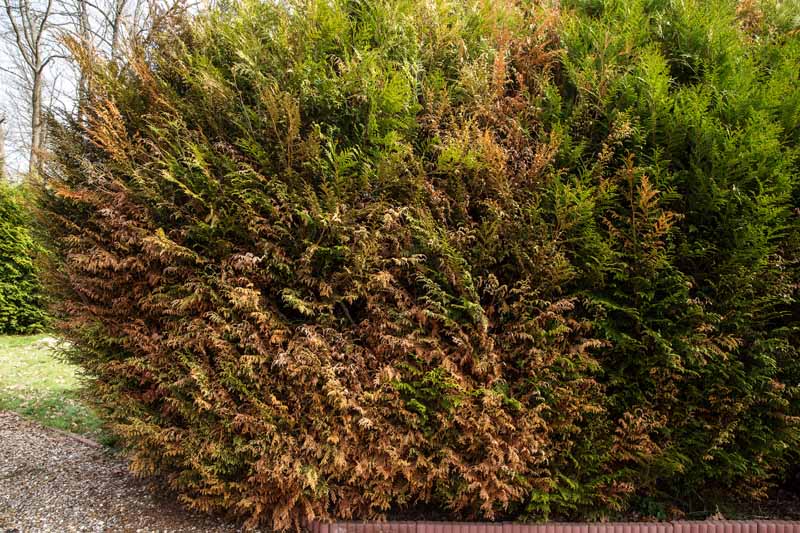
Root Rot
Identification: Root rot is a severe fungal disease that affects the roots of many plants, including hedges. One of the most common root rot diseases is Phytophthora. Symptoms may include wilting, yellowing or browning of leaves, stunted growth, and in severe cases, plant death. Infected roots often appear dark and mushy.
Treatment: Good drainage is crucial to prevent root rot. Avoid overwatering and ensure your soil has excellent drainage. If a plant is infected, you may need to remove it to prevent the disease from spreading. Fungicides can help, but they are most effective when used as a preventive measure rather than a cure. However, the over-use of fungicides can devastate the soil biota, removing beneficial fungi that can help fight against Phytophthora, inevitably causing more Phytopthora. “Right plant, right place” and correct watering procedures are much more effective.
Grey Box™ Westringia fruticosa ‘WES04’ PBR is extremely resistant to root rot diseases like phyotphora. Unlike most westringias, it can sit with wet feet for extended periods.
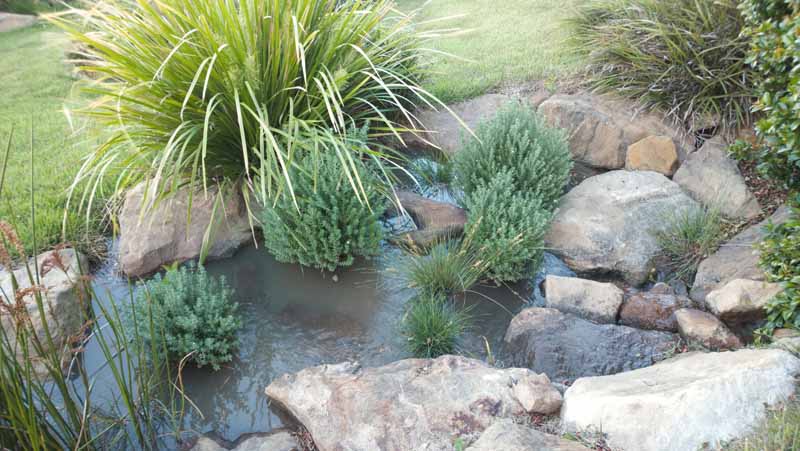
Mildew
Identification: Mildew is a fungal disease that causes a white, powdery growth on leaves and stems.
Treatment: Ensure good air circulation around your plants to prevent mildew. Avoid watering leaves, especially in the afternoon or evening. Fungicides can be used as a last resort, but susceptible plants may be nest replaced with something more resilient.
Mildew looks a bit similar to black sooty mould, but it’s greyish-white and often occurs in small patches that eventually meet up.
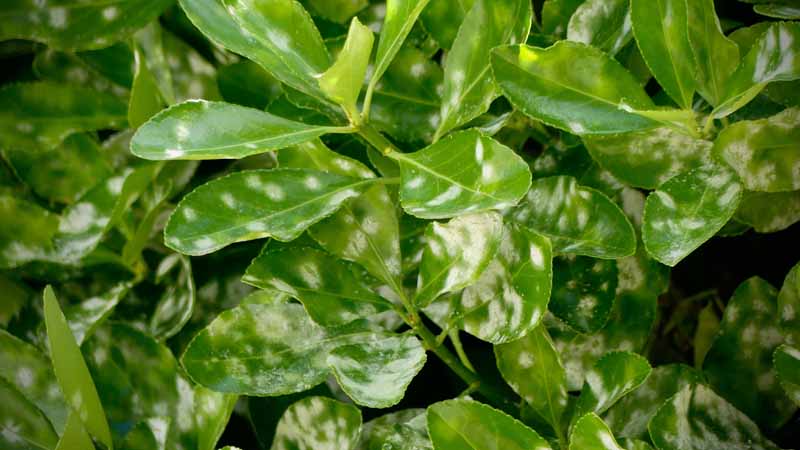
Conclusion
The health and vitality of your hedges can depend on your ability to recognise and address the various pests and diseases they may encounter. By using the information provided in this guide, you can keep an eye out for different types of pest and disease damage, and form an IPM plan to manage them.
A healthy garden will generally look after itself, with soil microbes, beneficial insects, birds, mammals, frogs, lizards and other fauna looking after our plants’ health. My personal favourite method of IPM is to “do nothing,” and simply watch as nature takes care of my problems for me.
Sometimes, replacing a weak plant with a stronger plant is the best move because it can limit chemical usage and decrease labour and maintenance costs for looking after a plant that will never be happy in its position.
Remember, early detection and intervention are key, and in many cases, prevention is the best cure. So, stay vigilant, implement the recommended treatments when necessary, and enjoy the numerous benefits that healthy, well-maintained hedges bring to your outdoor space.

